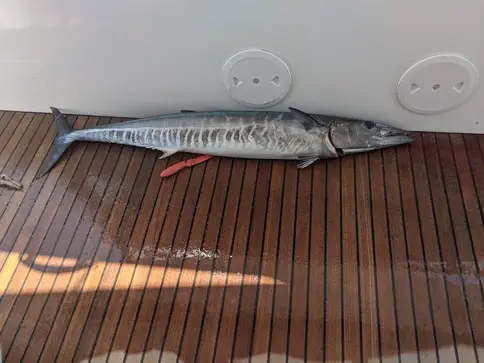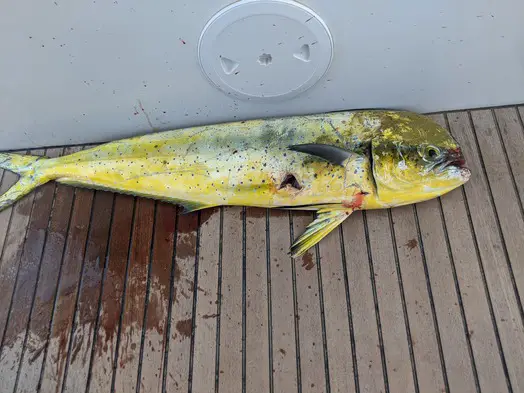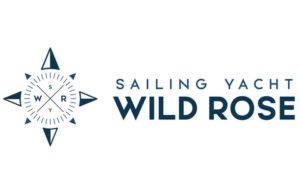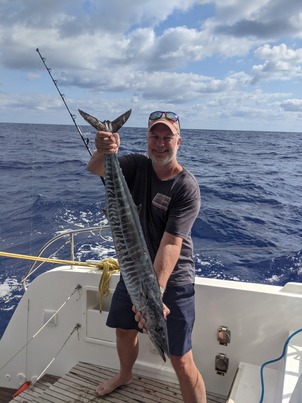Trolling from a sailboat is a great way to catch fish. As I sit here right now I’m in the Chesapaeake Bay and we’ve been catching bluefish and mackerel all summer. I prefer the open ocean where I can hook up with mahi or my favorite species, wahoo. Any fresh fish is a welcome addition to the galley on our boat. We usually don’t discriminate.
Trolling for fast ocean predators is not like fishing in your local pond or lake back home, which is what I grew up doing. All of the tackle needs to be bigger and more robust.
Rig
The first thing you need to determine is what type of fishing setup or rig you are going to use while trolling. There are basically two options, a traditional trolling rod and reel setup or a hand line. We carry and use both on our boat.
Hand Line
A hand line is pretty simple and by far the cheaper of the two. I recommend everyone carry a handl line setup on their boat. Basically you get 60 – 100 feet of 300 lb. monofilament line attach one end to the boat with a bungee cord and attach a lure to the other end and pull it behind the boat. I use a Cuban yoyo to wind it on for storage when I’m done. But it is about as simple and cheap as it gets. You can put the whole rig together for under $100.
You don’t need to spend a lot of money to catch fish while sailing.
If you are going on a bareboat charter I would bring two hand reel rigs and about five or six lures.
Rod & Reel
This can but doesn’t have to cost a lot more money. You can buy a Penn Senator reel and a simple rod and that will suffice for smaller game fish (up to 40 lbs.). These reels are not very expensive and you can get a rod and reel setup for a couple hundred bucks. This is a great starter rig.
If you are serious about fishing and catching big fish the Penn Senator will eventually get destroyed. It’s just not robust enough to reliably fight big tuna and marlin. So you eventually you might want to step up to something like a 50 weight Shimano TLD 50 or even an 80 weight Tiagra. These reels start at $500 and go up from there. The difference between these reels and the Penn Senator is they have more robust bearings and gears and they are two speed reels. You’ll pair it with a $300 to $500 rod and pretty soon you’re at or above $1000. This setup, properly cared for, will last a long time and handle anything you manage to get to bite your hook.
I currently have two Shimano TD50 LRSA two speed reels paired with a couple of Bass Pro Shops boat rods. I’ve had them for several years with no issues.
A word about fishing rods on sailboats. Many manufacturers make something called a boat rod. My rods are 5’6” long. Boat rods are short, stiff rods built for fighting big fish. You don’t want a really long rod, you will be taking it in and out of the boat or lockers and you need to sometimes fit it in tight spaces for storage, a seven or eight foot rod is way too long to have on a sailboat.
Lures
I have had fish hit just about any lure I put behind the boat. But I definitely prefer some lures to others. Here is a link to the top ten lures I prefer.
Pro Tip: Keep Your Hooks Sharp
Keep the hooks on your lures very sharp. Don’t spend all of the time and money on fishing gear and toss a lure in the ocean with a dull hook. You can sharpen a hook with a small file, ceramic rod or a purpose built hook sharpener. This is going to increase your catch rate.
Speed
You cannot go too fast, as a matter of fact on a sailboat you are almost always going to be going a little too slow. Pelagic ocean fish like mahi, tuna and wahoo can swim much faster than you can sail. These species can go 40 miles per hour, you’re not going to sail that fast. There are people of regularly troll for wahoo at speeds approaching 20 knots.
Regarding speed, you should be far more worried about going too slow rather than too fast. I still keep lures out when going pretty slow. It only takes one dumb fish to provide me with some mahi tacos.
Vary Line Length
Most people say keep the lure anywhere from a boat length or two behind the boat. Mahi have no problem hitting these, but I find tuna to be a little more skittish of boats. So in my spread I will have lines anywhere from 60 to 200 feet back. If I only could use one handline though I would place it at 60 feet behind my boat.

Pro Tip: Vary Lure Depth
One of the most important things you can do while trolling is to get your lures deeper in the water column. Most people only fish lures that are trolled on or just below the surface. You will catch fish on these, but often fish don’t want to go up to the surface to feed. These same fish will hit a lure that is 15 or 20 feet below the surface.
So you have a couple of options, first you can get a deeper diving lure. I have some lures that dive from 10 to 15 feet. These are great, and I definitely deploy them in my spread. However, the best kept secret for sailboat fishing is using a planer.
There are many sizes of planers and the bigger they are the deeper they will take your lure. There are a couple of ways to rig these, but I prefer to do it in-line with really small swivels that I can reel right through the guides on my rods. I don’t feel the need to go any larger than a number three of four planer, and usually use a number two. I prefer the Old Salty brand, but I think they’re all pretty much the same.
Where to Fish
If I am in shallow water I generally don’t fish. Most of the time I catch barracuda in shallow water and a lot of places you cannot eat barracuda due to ciguatera. I hear of a lot of people catching grouper or snapper in shallow water, but I have never gotten one. Now when the water gets deeper, maybe 60 to 100 feet or so there are big drop-offs this is where I start to get excited. Look for areas that drop off from 60 to several hundred feet or deeper. Fish congregate at these drop off points and that is where you are likely to catch them.
That said, if I am on passage I am going to be fishing and it’s usually in thousands of feet of water. Catching a wahoo in thousands of feet of water hundreds of miles offshore is a thrill. Eating fresh wahoo tacos hundreds of miles from shore is even better.
Look for Birds
When you’re fishing you need to look for activity at the surface of the water. This could be birds diving or disturbance at the water. What you’re really trying to find is the baitball (small schooling fish) under the surface of the water. These attract larger pelagic fish species and birds that feed on them. If you find something like this steer a course to put you right in the middle of the activity. If I’m motoring I might even make a few passes through it.
Do Not Stop the Boat
Once you get a fish on, either with a handline or conventional rod and reel setup you may need to slow the boat down. If it is on a handline, often the fish will ski or hydroplane on the surface of the water. In that case no need to slow down.
What is more often the case on a rod and reel is that the fish will not hydroplane and if you’re fighting even a 20 lb. wahoo and the boat is going six knots you are in for a really tough fight and stand a change of pulling the hook out of the fish’s mouth. So slow the boat down by rolling in the jib, or easing out the main or both. Every boat is a little different, and it depends on your point of sail, but slowing the boat down to two or three knots usually makes a world of difference.
Should I Keep This Fish?
Most of the time when I’m fishing I get a mahi or wahoo on the line the decision is really easy if I’m going to keep it or not. The answer is YES! But what if you hook a big marlin or sailfish? You might have a big decision to make if you catch a big fish. I’m not personally interested in keeping a sailfish, they’re too beautiful and I let those go. Although I’m not opposed to keeping a big marlin, even if my freezer was totally empty I don’t think I could fit it all in there. I’d have to be buddy boating with someone who had a bunch of freezer space or maybe a couple of boats for me to justify keeping a marlin. It’s better to make this decision before landing a fish as to what you will or won’t keep.
Normally what we catch are mahi and wahoo in the 15 – 30 lb. range and we keep all of those.

Gaff or no Gaff
If you catch a big fish you’re probably going to need to gaff it to bring it over the side. But what about the smaller ones. Lots of people just flip them over the side or back of the boat onto the deck rather than gaffing them. Gaffing a fish presents its own problems. Gaffs have pointy ends on them that are dangerous, especially with a flopping fish on the end of it. I prefer to not gaff, especially if I’m on a long passage with smaller fish. But not gaffing a fish will definitely increase the amount of fish you lose when inevitably one or two flips off the hook while you are swinging it on the deck.
One option if you have a speargun is to spear it when it’s still in the water. Then you just let it die and bleed out in the water before bringing it on board.
Pro Tip: Get Saltwater on the Deck
When you bring a fish aboard blood and scales are going to get on the boat, it’s inevitable. If you get the deck wet before or just after you bring the fish aboard the blood and scales are much easier to remove from the boat.
Rinse in Saltwater Only
Once you have your catch on the boat and start to fillet it or cut it into steaks don’t ruin it by rinsing it in fresh water. Only rinse fish in salt water. Just fill up a bucket with sea water and rinse your fish in that before putting it in Ziploc bags.
Gear
Aside from rod and reel or a hand line there are a few pieces of other essential gear you should have.
Pliers
Oceangoing fish can have big teeth. One of my main goals is to keep my hands as far away as possible from big fish teeth. When fingers and teeth come together the fingers are going to lose every time. So when I do need to get a hook out of a live fish I always use pliers. Any pliers will do, sometimes I use my Leatherman, sometimes I use these fancy fishing pliers.
Filet Knife
You actually do not absolutely have to have a fillet knife, often I just use one of my galley knives, but I do have a couple of fillet knives on the boat for smaller fish.
Lures
As stated above, here is a link to my post on my favorite lures to use while trolling. Vary them up while fishing, I generally like bright colors, but any of them will catch fish.
Hooks
Eventually your hooks will get rusty or the tip may get broken off, you can either buy a new lure or replace the hook. I like Mustad 9/0 hooks for saltwater trolling.
Swivels
Whether you go with a handline setup or a rod and reel you are going to need some swivels. Lures will spin and twist up your line causing you a headache, swivels eliminate this problem.
Rod Holders
If you go the rod and reel route you will need a rod holder or two, depending on how many rods you deploy. We have had two Taco Marine Clamp On Rod Holders for years, they are constantly covered in salt water and have yet to show any signs of rust.

